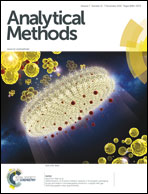Comparative assessment of the chromatographic separation of 2,3,7,8-substituted polychlorinated dibenzo-p-dioxins and polychlorinated dibenzofurans using supercritical fluid chromatography and high resolution gas chromatography†
Abstract
The analysis of legacy environmental contaminants, such as polychlorinated dibenzo-p-dioxins (PCDDs) and dibenzofurans (PCDFs), using high resolution gas chromatography (HRGC) is well established and universally accepted. The use of an alternative separation technique, such as packed column supercritical fluid chromatography (pSFC), may be of interest as a fast, green, and cost effective method of analyzing environmental samples. The technique is amenable to a broad range of chemical compounds and could facilitate the simultaneous analysis of multiple compound classes as well as the inclusion of thermally labile compounds in a single targeted analysis. The recent re-emergence of this technology due to the introduction of more robust and efficient instrumentation may result in an increased acceptance of pSFC analytical techniques in this area. Herein, the first reported analytical separation of PCDDs and PCDFs by pSFC is described and its separation capabilities are compared with established HRGC protocols. Elution profiles of 2,3,7,8-substituted PCDDs and PCDFs were examined and the separation of PCDD/PCDF homologue groups was found to be comparable to those accomplished using HRGC. Similarly, the resolution of tetrachlorodibenzo-p-dioxin (TCDD) congeners, as required by current regulatory methods utilizing HRGC, was demonstrated and the separation of possible co-eluting PCDD/PCDF congeners was examined and compared to that achieved using popular HRGC capillary columns. The possibility of concurrent analysis of toxic polychlorinated biphenyls (PCBs) with PCDDs and PCDFs using the developed pSFC method was also investigated. The effective separation of these environmental contaminants obtained using pSFC and subsequent detection utilizing atmospheric pressure photoionization tandem mass spectrometry at environmentally relevant levels demonstrates the promise associated with this technique for the analysis of environmental extracts.


 Please wait while we load your content...
Please wait while we load your content...